NCERT Solutions for Exercise 8.1 Class 10 Maths Chapter 8 - Introduction to Trigonometry
The exercise establishes basic trigonometric foundations by teaching about the six vital ratios, which include sine, cosine, tangent, cosecant, secant and cotangent. The ratios help us to understand angle-per-length relationships through right-angled triangles. We have to master the exercise because it creates essential foundations for higher-level trigonometric subjects and serves as a key part of the Class 10 mathematics syllabus.
This Story also Contains
- NCERT Solutions Class 10 Maths Chapter 8: Exercise 8.1
- Access Solution of Introduction to Trigonometry Class 10 Chapter 8 Exercise: 8.1
- Topics covered in Chapter 8, Introduction to Trigonometry: Exercise 8.1
- NCERT Solutions of Class 10 Subject Wise
- NCERT Exemplar Solutions of Class 10 Subject Wise
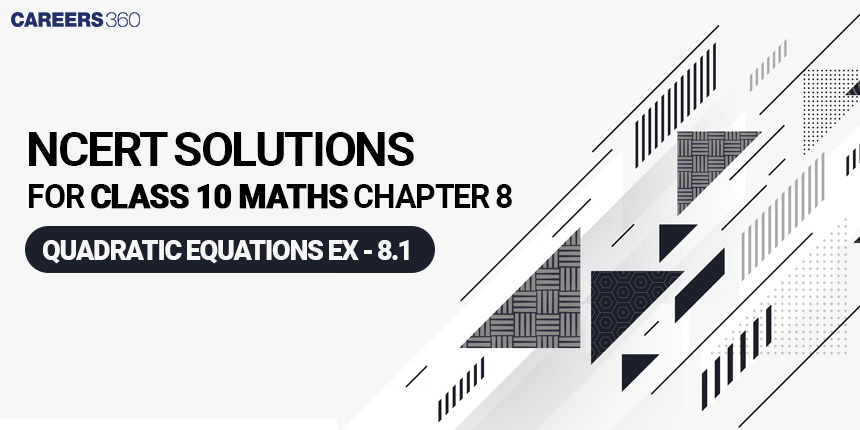
The NCERT Solutions for Class 10 Maths present practical methods for using trigonometric ratios according to the content found in NCERT textbooks. The exercises guide students to evaluate trigonometric ratios when given dimensional triangle measurements and help students determine missing lengths through ratio analysis while confirming trigonometric identity relations. Exercise 8.1 in the NCERT Books helps students strengthen their trigonometry knowledge as it develops their ability to solve complex mathematical problems required for higher educational levels.
NCERT Solutions Class 10 Maths Chapter 8: Exercise 8.1
Access Solution of Introduction to Trigonometry Class 10 Chapter 8 Exercise: 8.1
Q1 In $\Delta \: ABC$ , right-angled at $B, AB = 24 \: cm$ , $BC = 7 \: cm$ . Determine : $(i)\; \sin A, \cos A$ $(ii)\; \sin C, \cos C$
Answer:
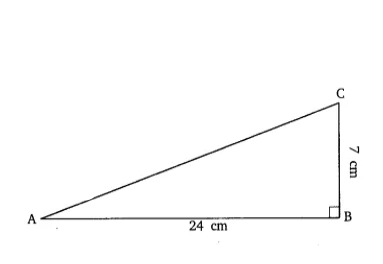
We have,
In $\Delta \: ABC$ , $\angle$ B = 90, and the length of the base (AB) = 24 cm and length of perpendicular (BC) = 7 cm
So, by using Pythagoras theorem,
$\\AC^2 = AB^2 + BC^2\\ AC = \sqrt{AB^2+BC^2}$
Therefore, $AC = \sqrt{576+49}$
$AC = \sqrt{625}$
AC = 25 cm
Now,
(i) $\sin A = P/H = BC/AB = 7/25$
$\cos A = B/H = BA/AC = 24/25$
(ii) For angle C, AB is perpendicular to the base (BC). Here B indicates to Base and P means perpendicular wrt angle $\angle$ C
So, $\sin C = P/H = BA/AC = 24/25$
and $\cos C = B/H = BC/AC = 7/25$
Q2 In Fig. 8.13, find $\tan P - \cot R$ .
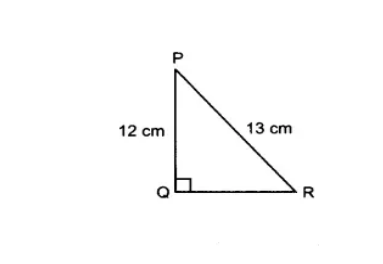
Answer:
We have, $\Delta$ PQR is a right-angled triangle, length of PQ and PR are 12 cm and 13 cm respectively.
So, by using Pythagoras theorem,
$QR = \sqrt{13^2-12^2}$
$QR = \sqrt{169-144}$
$QR = \sqrt{25} = 5\ cm$
Now, According to question,
$\tan P -\cot R$ = $\frac{RQ}{QP}-\frac{QR}{PQ}$
= 5/12 - 5/12 = 0
Q3 If $\sin A=\frac{3}{4},$ calculate $\cos A$ and $\tan A$ .
Answer:
Suppose $\Delta$ ABC is a right-angled triangle in which $\angle B = 90^0$ and we have $\sin A=\frac{3}{4},$
So,
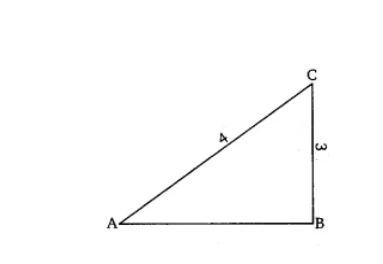
Let the length of AB be 4 unit and the length of BC = 3 unit So, by using Pythagoras theorem,
$AB = \sqrt{16-9} = \sqrt{7}$ units
Therefore,
$\cos A = \frac{AB}{AC} = \frac{\sqrt{7}}{4}$ and $\tan A = \frac{BC}{AB} = \frac{3}{\sqrt{7}}$
Q4 Given $15 \: \cot A=8,$ find $\sin A$ and $\sec A$ .
Answer:
We have,
$15 \: \cot A=8,$ $\Rightarrow \cot A =8/15$
It implies that In the triangle ABC in which $\angle B =90^0$ . The length of AB be 8 units and the length of BC = 15 units
Now, by using Pythagoras theorem,
$AC = \sqrt{64 +225} = \sqrt{289}$
$\Rightarrow AC =17$ units
So, $\sin A = \frac{BC}{AC} = \frac{15}{17}$
and $\sec A = \frac{AC}{AB} = \frac{17}{8}$
Q5 Given $\sec \theta =\frac{13}{12},$ calculate all other trigonometric ratios.
Answer:
We have,
$\sec \theta =\frac{13}{12},$
It means the Hypotenuse of the triangle is 13 units and the base is 12 units.
Let ABC is a right-angled triangle in which $\angle$ B is 90 and AB is the base, BC is perpendicular height and AC is the hypotenuse.
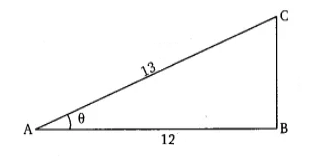
By using Pythagoras theorem,
$BC = \sqrt{169-144}=\sqrt{25}$
BC = 5 unit
Therefore,
$\sin \theta = \frac{BC}{AC}=\frac{5}{13}$
$\cos \theta = \frac{BA}{AC}=\frac{12}{13}$
$\tan \theta = \frac{BC}{AB}=\frac{5}{12}$
$\cot \theta = \frac{BA}{BC}=\frac{12}{5}$
$\sec \theta = \frac{AC}{AB}=\frac{13}{12}$
$\csc \theta = \frac{AC}{BC}=\frac{13}{5}$
Answer:
We have, A and B are two acute angles of triangle ABC and $\cos A =\cos B$
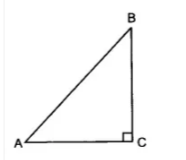
According to question, In triangle ABC,
$\cos A =\cos B$
$\frac{AC}{AB}=\frac{BC}{AB}$
$\Rightarrow AC = AB$
Therefore, $\angle$ A = $\angle$ B [angle opposite to equal sides are equal]
Q7 If $\cot \theta =\frac{7}{8},$ evaluate: $(i)\; \frac{(1+\sin \theta)(1-\sin \theta)}{(1+\cos \theta)(1-\cos \theta)}$ $(ii)\; \cot ^{2}\theta$
Answer:
Given that,
$\cot \theta =\frac{7}{8}$
$\therefore$ perpendicular (AB) = 8 units and Base (AB) = 7 units
Draw a right-angled triangle ABC in which $\angle B =90^0$
Now, By using Pythagoras theorem,
$AC^2 = AB^2+BC^2$
$AC = \sqrt{64 +49} =\sqrt{113}$
So, $\sin \theta = \frac{BC}{AC} = \frac{8}{\sqrt{113}}$
and $\cos \theta = \frac{AB}{AC} = \frac{7}{\sqrt{113}}$
$\Rightarrow \cot \theta =\frac{\cos \theta}{\sin \theta} = \frac{7}{8}$
$(i)\; \frac{(1+\sin \theta)(1-\sin \theta)}{(1+\cos \theta)(1-\cos \theta)}$
$\Rightarrow \frac{(1-\sin^2\theta)}{(1-\cos^2\theta)} = \frac{\cos^2\theta}{\sin^2\theta} = \cot ^2\theta$
$=(\frac{7}{8})^2 = \frac{49}{64}$
$(ii)\; \cot ^{2}\theta$
$=(\frac{7}{8})^2 = \frac{49}{64}$
Q8 If $3\cot A=4,$ check wether $\frac{1-\tan ^{2}A}{1+\tan ^{2}A}=\cos ^{2}A-\sin ^{2}A$ or not.
Answer:
Given that,
$3\cot A=4,$
$\Rightarrow \cot = \frac{4}{3} = \frac{base}{perp.}$
ABC is a right-angled triangle in which $\angle B =90^0$ and the length of the base AB is 4 units and length of perpendicular is 3 units
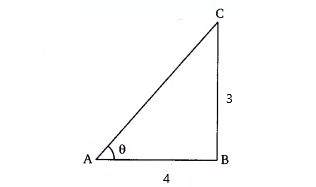
By using Pythagoras theorem, In triangle ABC,
$\\AC^2=AB^2+BC^2\\ AC = \sqrt{16+9}\\ AC = \sqrt{25}$
AC = 5 units
So,
$\tan A = \frac{BC}{AB} = \frac{3}{4}$
$\cos A = \frac{AB}{AC} = \frac{4}{5}$
$\sin A = \frac{BC}{AC} = \frac{3}{5}$
$\frac{1-\tan ^{2}A}{1+\tan ^{2}A}=\cos ^{2}A-\sin ^{2}A$
Put the values of above trigonometric ratios, we get;
$\Rightarrow \frac{1-9/4}{1+9/4} = \frac{16}{25}-\frac{9}{25}$
$\Rightarrow -\frac{5}{13} \neq \frac{7}{25}$
LHS $\neq$ RHS
Q9 In triangle $ABC$ , right-angled at $B$ , if $\tan A =\frac{1}{\sqrt{3}},$ find the value of:
$(i) \sin A\: \cos C + \cos A\: \sin C$
$(ii) \cos A\: \cos C + \sin A\: \sin C$
Answer:
Given a triangle ABC, right-angled at B and $\tan A =\frac{1}{\sqrt{3}}$ $\Rightarrow A=30^0$
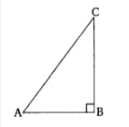
According to question, $\tan A =\frac{1}{\sqrt{3}} = \frac{BC}{AB}$
By using Pythagoras theorem,
$\\AC^2 = AB^2+BC^2\\ AC = \sqrt{1+3} =\sqrt{4}$
AC = 2
Now,
$\\\sin A = \frac{BC}{AC} = \frac{1}{2}\\ \sin C =\frac{AB}{AC} = \frac{\sqrt{3}}{2}\\ \cos A = \frac{AB}{AC} = \frac{\sqrt{3}}{2}\\ \cos C = \frac{BC}{AC} = \frac{1}{2}$
Therefore,
$(i) \sin A\: \cos C + \cos A\: \sin C$
$\\\Rightarrow \frac{1}{2}\times\frac{1}{2}+\frac{\sqrt{3}}{2}\times \frac{\sqrt{3}}{2}\\ \Rightarrow1/4 +3/4\\ \Rightarrow4/4 = 1$
$(ii) \cos A\: \cos C + \sin A\: \sin C$
$\\\Rightarrow \frac{\sqrt{3}}{2}\times \frac{1}{2}+\frac{1}{2}\times\frac{\sqrt{3}}{2}\\ \Rightarrow \frac{\sqrt{3}}{4}+\frac{\sqrt{3}}{4}\\ \Rightarrow \frac{\sqrt{3}}{2}$
Answer:
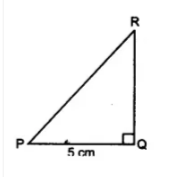
We have, PR + QR = 25 cm.............(i)
PQ = 5 cm
and $\angle Q =90^0$
According to question,
In triangle $\Delta$ PQR,
By using Pythagoras theorem,
$\\PR^2 = PQ^2+QR^2\\ PQ^2 =PR^2-QR^2 \\ 5^2= (PR-QR)(PR+QR)\\ 25 = 25(PR-QR) \\$
PR - QR = 1........(ii)
From equation(i) and equation(ii), we get;
PR = 13 cm and QR = 12 cm.
therefore,
$\\\sin P= \frac{QR}{PR}= 12/13\\ \cos P = \frac{PQ}{RP} = 5/13\\ \therefore \tan P = \frac{\sin P}{\cos P} = 12/5$
Q11 State whether the following are true or false. Justify your answer.
(i) The value of $\tan A$ is always less than 1.
(ii) $\sec A=\frac{12}{5}$ for some value of angle A.
(iii) $\cos A$ is the abbreviation used for the cosecant of angle A.
(iv) $\cot A$ is the product of cot and A.
(v) $\sin \Theta =\frac{4}{3}$ for some angle $\Theta .$
Answer:
(i) False,
because $\tan 60 = \sqrt{3}$ , which is greater than 1
(ii) True,
because $\sec A \geq 1$
(iii) False,
Because $\cos A$ abbreviation is used for cosine A.
(iv) False,
because the term $\cot A$ is a single term, not a product.
(v) False,
because $\sin \theta$ lies between (-1 to +1) [ $-1\leq \sin \theta\leq 1$ ]
Topics covered in Chapter 8, Introduction to Trigonometry: Exercise 8.1
1. Calculating Trigonometric Ratios: Individuals can determine the values of trigonometric ratios when given the lengths of right-angled triangles.
2. Determining Side Lengths: Calculating the unknown side lengths of right-angled triangles becomes possible when applying known trigonometric ratios.
3. Verifying Trigonometric Identities: By using both calculation and reasoning, students verify fundamental trigonometric identities.
4. Real-Life Applications: Applying trigonometric principles helps solve real-life situations where trigonometry measures sides and angles in practical problems.
5. Definition of Trigonometric Ratios: Understanding sine, cosine, tangent, cosecant, secant, and cotangent in the context of right-angled triangles.
Trigonometric Ratios | Formula |
sin θ | $\frac{\text{Perpendicular}}{\text{Hypotenuse}}$ |
cos θ | $\frac{\text{Base}}{\text{Hypotenuse}}$ |
tan θ | $\frac{\text{Perpendicular}}{\text{Base}}$ |
cosec θ | $\frac{\text{Hypotenuse}}{\text{Perpendicular}}$ |
sec θ | $\frac{\text{Hypotenuse}}{\text{Base}}$ |
cot θ | $\frac{\text{Base}}{\text{Perpendicular}}$ |
Also, see-
NCERT Solutions of Class 10 Subject Wise
Students must check the NCERT solutions for class 10 of Mathematics and Science Subjects.
NCERT Exemplar Solutions of Class 10 Subject Wise
Students must check the NCERT Exemplar solutions for class 10 of Mathematics and Science Subjects.
Frequently Asked Questions (FAQs)
Cos means Cosine is the ratio of Adjacent Side and Hypotenuse
tan θ=sin θ/cos θ
The multiplicative inverse of sine is known as the cosecant
The six trigonometric ratios are
Sine
Cosine
Tangent
Cotangent
Cosecant
Secant.
NCERT solutions for Class 10 Maths chapter 8 exercise 8. 1 consists of 11 Questions in which 7 are short answers, 3 of them are long answers and the remaining one is a short answer with reasoning and all the questions are based on trigonometric ratios.
The three basic trigonometric ratios are sine, cosine and tangent.
The ratio of the opposite side to the hypotenuse of the right angle triangle is known as the sine.
Sin θ=opposite side/hypotenuse
Questions related to CBSE Class 10th
On Question asked by student community
Good Morning, candidate,
The question papers will be available soon at the link attached herewith. You can keep an eye on the website of careers360. it will provide you perfect pattern of question papers, which will improve your writing skills and practice learning.
https://school.careers360.com/articles/cbse-sahodaya-class-10-pre-board- question-paper-2025-26
Thank you.
Hello,
You can download subject wise CBSE Sahodaya Class 10 Pre-Board Question Paper 2025-26 for Round 1 & Round 2 from this link : CBSE Sahodaya Class 10 Pre-Board Question Paper 2025-26
Hope it helps !
The Sahodaya School Complex Examinations (including those for the Chennai cluster) for the 2025-2026 academic session are generally conducted in a decentralized manner by regional clusters of CBSE schools.
The linked page provides access to the latest Sahodaya Question Papers for Class 10 and Class 12 that follow the current
Hello there,
Solving question papers is one of the best method of preparation. It gives you proper idea about the exam pattern and important topics to cover.
Here is the link attached from the official website of Careers360 which will provide you with the CBSE Sahodaya question papers. Hope it
https://school.careers360.com/articles/cbse-sahodaya-class-10-pre-board-question-paper-2025-26
Hello,
The above link will open the website of the questions and answer key. scroll down, and you will find the question sets. Some of them will be available soon.
Thank You.
Popular CBSE Class 10th Questions
Applications for Admissions are open.
As per latest syllabus. Physics formulas, equations, & laws of class 11 & 12th chapters
JEE Main Important Chemistry formulas
Get nowAs per latest syllabus. Chemistry formulas, equations, & laws of class 11 & 12th chapters
JEE Main high scoring chapters and topics
Get nowAs per latest 2024 syllabus. Study 40% syllabus and score upto 100% marks in JEE
JEE Main Important Mathematics Formulas
Get nowAs per latest syllabus. Maths formulas, equations, & theorems of class 11 & 12th chapters
